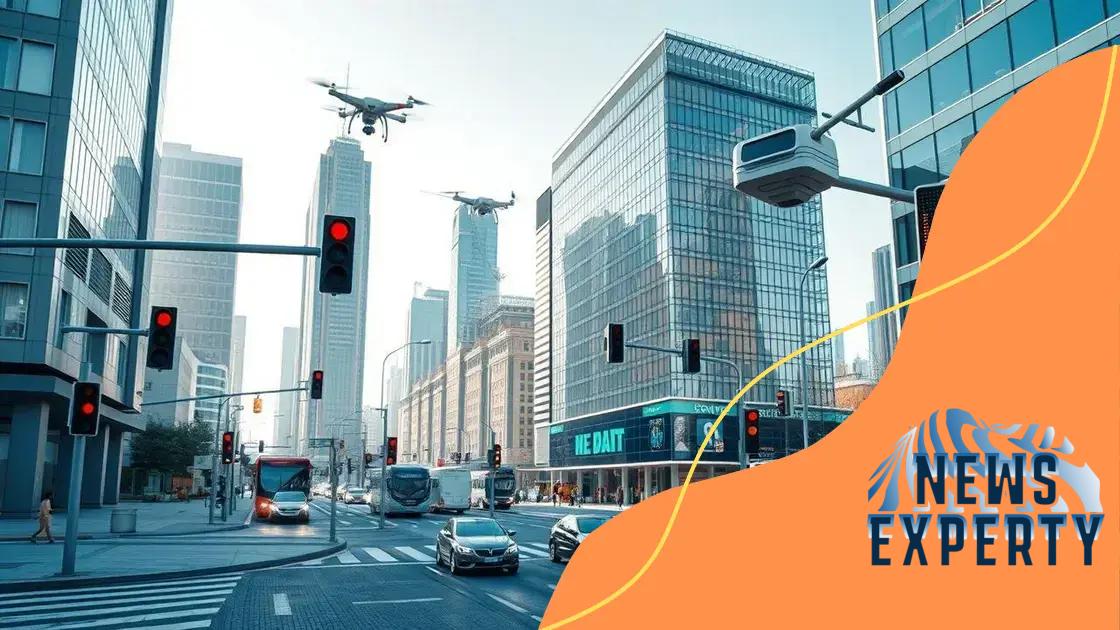5G smart cities: The connected future is here

Anúncios
5G smart cities are no longer just a futuristic concept, they’re quickly becoming the present. As 5G rolls out across urban landscapes, it’s reshaping how cities function and how we interact with them every day.
Whether you’re navigating morning traffic or managing urban infrastructure, 5G is quietly powering your experience. Let’s take a closer look at how this revolutionary shift is transforming city life, starting now.
The basics of 5G technology
5G smart cities begin with understanding the engine behind them, 5G itself. This technology brings ultra-fast speeds and low latency to a new level, allowing cities to communicate, operate, and evolve in real time.
Anúncios
What is 5G?
At its core, 5G is the next evolution of wireless technology, built to outperform its predecessors. It operates across a wider range of frequencies, enabling more reliable and flexible connections.
Beyond just being faster, 5G supports vast data transfers with minimal delay. This makes it possible for thousands of devices to function seamlessly in one city block.
It’s this foundation that fuels smart traffic systems, IoT applications, and instant communication between urban services. Without 5G, a truly smart city remains out of reach.
Anúncios
Key features of 5G
In 5G smart cities, the standout features of this technology are what set them apart. Think ultra-high-speed data transfers, 20 Gbps or more, and a dramatic drop in latency to milliseconds.
These advances enable cities to connect everything from streetlights to security systems. The network can handle massive data loads without crashing, even during peak times.
This reliability ensures continuous performance in areas like public safety, environmental monitoring, and traffic control, critical components of efficient urban management.
5G’s ability to support billions of IoT devices in a small area means smarter energy grids, responsive infrastructure, and streamlined city services. It’s more than speed, it’s about enabling cities to think for themselves.
Key benefits of 5G for smart cities
5G smart cities benefit from a web of improvements that touch every part of daily life. This technology doesn’t just make things faster, it makes everything work better, together.
Improved connectivity
Cities thrive on communication, and 5G enables devices, systems, and infrastructure to speak the same language in real time. This synergy cuts down on delays and manual input.
Imagine a world where traffic lights react instantly to congestion or where emergency responders receive live data feeds before they arrive. That’s 5G-enabled responsiveness.
This constant communication between urban systems helps reduce downtime, improve services, and boost overall efficiency in the city environment.
Smart infrastructure
When cities adopt 5G, infrastructure becomes adaptive. Roads, bridges, and buildings evolve into intelligent assets that monitor themselves and their surroundings.
For instance, dynamic traffic systems can shift based on vehicle flow. Sensors in buildings detect issues before they become disasters, enabling proactive repairs.
5G also allows energy grids to self-regulate, lighting systems to adjust automatically, and waste collection to become data-driven, all key components of sustainable urban planning.
Real-world examples of 5G implementations
Exploring real-world examples of 5G implementations showcases how cities are integrating this technology into their infrastructure to enhance urban living. Various pioneering cities are stepping up to embrace 5G, leading to significant advancements.
Smart traffic management
In Los Angeles, 5G powers adaptive traffic lights that respond instantly to changes in vehicle flow. This has led to smoother commutes and reduced carbon emissions.
Cars communicate with infrastructure, optimizing routes and reducing idle time. These improvements are especially critical in cities grappling with gridlock.
As data from road sensors is processed in real time, decisions happen on the fly, making urban mobility smarter and faster.
Enhanced public safety
Kuala Lumpur is deploying 5G surveillance systems that provide real-time video feeds to emergency services. This speeds up response times and improves situational awareness.
Police and ambulances receive instant updates, streamlining interventions and increasing safety for everyone. Every second saved can mean a life saved.
Elsewhere, smart lighting and noise monitoring further enhance safety, adapting to crowd activity or unusual events without human intervention.

Challenges to overcome with 5G deployment
Deploying 5G technology presents various challenges that cities and service providers need to address. Understanding these obstacles is essential for ensuring successful integration into urban environments.
Infrastructure requirements
Building a 5G network requires dense placement of small cell towers. These aren’t like traditional towers, they’re smaller but must be installed more frequently across urban areas.
Cities must update buildings, utility poles, and rooftops to accommodate this. The cost, planning, and logistics can delay deployment, especially in older or crowded regions.
Without proper infrastructure, the full potential of 5G remains out of reach, slowing the path to smarter cities.
Regulatory hurdles
Local laws and zoning restrictions often complicate 5G expansion. Permits can take months, and resistance from communities about tower aesthetics or health concerns adds pressure.
Collaboration between telecom providers, governments, and citizens is essential. Without it, cities may face uneven access and missed opportunities.
Public transparency and education are key to overcoming resistance and ensuring smooth implementation across all neighborhoods.
The future of urban living with 5G
The future of urban living with 5G holds exciting possibilities that will reshape how we interact with our cities. As 5G technology continues to expand, our urban environments are poised to become more efficient, connected, and sustainable.
Smart homes and buildings
Imagine a building that knows when to adjust lighting, temperature, or even elevator availability based on its occupants’ behavior. That’s the power of 5G in residential life.
Homeowners can manage appliances, security, and energy use from their phones, no delays, no glitches. Every device speaks the same digital language.
This not only saves money but also reduces energy consumption, contributing to a greener urban footprint.
Enhanced public services
Public transport will be one of the biggest beneficiaries. 5G enables trains and buses to share real-time updates with passengers and traffic systems.
Riders get instant alerts about delays, reroutes, or arrival times, improving satisfaction and increasing efficiency. Traffic lights adjust automatically to prioritize transit lanes.
These small efficiencies add up, resulting in faster commutes, lower emissions, and better use of city resources.
5G smart cities are no longer hypothetical, they are being built right now, one sensor, one network, one innovation at a time. This transformative technology is reshaping the way cities operate, solve problems, and connect with residents.
From smarter infrastructure to enhanced public safety, the benefits are undeniable. But for 5G to truly fulfill its potential, cities must overcome technical, regulatory, and social hurdles with care and foresight.
As adoption spreads and technology matures, 5G smart cities will become the global standard. The result? Urban living that’s faster, safer, more efficient, and ready for the future.
FAQ – Frequently Asked Questions about 5G and Smart Cities
How does 5G technology enhance urban living?
5G technology provides faster internet speeds and improved connectivity, enabling smart city infrastructure and optimized public services.
What are some real-world applications of 5G in cities?
Cities use 5G for smart traffic management, connected emergency services, and improved healthcare access through telemedicine.
What challenges do cities face when deploying 5G?
Challenges include infrastructure upgrades, regulatory hurdles, cybersecurity concerns, and ensuring equitable access across all communities.
What is the future potential of 5G in urban environments?
The future includes smarter homes, enhanced public transport, sustainable energy solutions, and more efficient public services, all connected by 5G.





